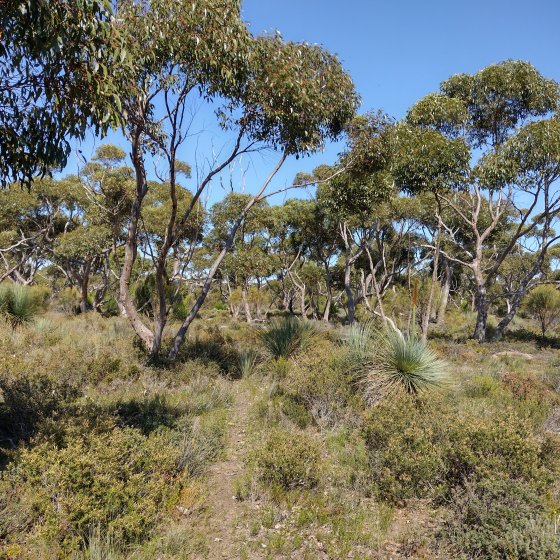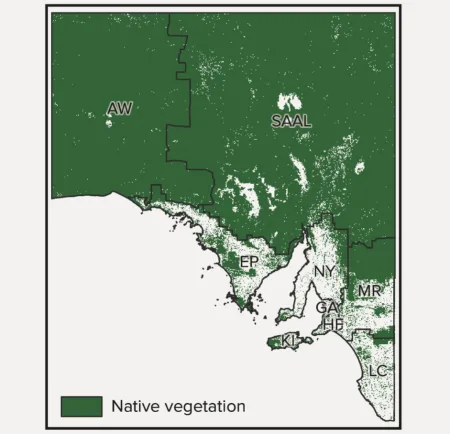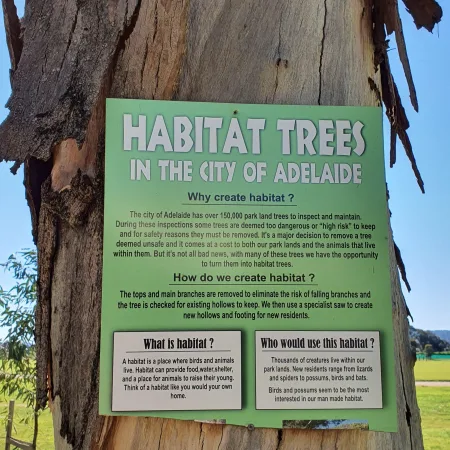- Home
- Environmental Themes
- Land
- State of Our Land
- Habitats
Habitats
South Australia is a diverse state in terms of land habitats, which include:
- Coastal Areas: South Australia has a long coastline that stretches along the Southern Ocean and the Great Australian Bight. The coastal areas encompass sandy beaches, rocky cliffs, dunes, estuaries and coastal saltmarshes and wetlands. These habitats support a variety of terrestrial, marine and bird species.
- Mallee and Scrublands: Mallee and scrublands dominate much of South Australia's interior regions. Mallee is characterised by small, multi-stemmed eucalyptus trees, while scrublands consist of low shrubs and heath vegetation. These habitats are adapted to the semi-arid conditions and support a range of wildlife, including reptiles, small mammals and bird species.
- Rangelands: The rangelands of South Australia are vast open grasslands and savannas. These habitats are found in the northern and western parts of the state and support grazing animals such as kangaroos, emus and feral goats.
- Wetlands: South Australia is home to many wetlands, including six RAMSAR wetlands of international importance (for example, the Coorong, Lake Alexandrina and Lake Albert). These wetlands provide important breeding and feeding grounds for waterbirds, including migratory species. They also support a variety of fish, amphibians and plant species.
- Riverine Systems: The major rivers in South Australia, such as the River Murray and its tributaries, create diverse riverine habitats. These habitats include floodplains, billabongs and riparian vegetation that support a wide range of aquatic and terrestrial species.
- Arid and Desert Regions: Much of South Australia's interior is characterised by arid and desert landscapes, such as the Flinders Ranges and the Simpson Desert. These habitats are harsh and dry, but they still support unique arid-adapted plants, reptiles and small mammals.
- Woodlands and Forests: In the southern parts of South Australia you can find pockets of woodlands and forests, primarily dominated by eucalyptus trees. These habitats are more abundant in the Mount Lofty Ranges and provide habitat for a variety of bird species and mammals like koalas and possums.
It is important to note that these habitat types can overlap and transition into one another, creating a mosaic of ecosystems within South Australia. The state's unique combination of coastal, arid and forested habitats contributes to its rich biodiversity.
The National Land Cover Account releases data on land coverage at a national and state/territorial scale. There has been a slight decline in cultivated vegetation cover, which is consistent with national reporting in the National Land Cover Account report and likely to have been driven by improved land management practices that have incorporated nature conservation and managed resource protection. Natural surfaces appear to have been increasing since 2008. The area of herbaceous natural surfaces has declined slightly. Data in the report shows that herbaceous and natural surfaces tend to be influenced by rainfall, with herbaceous cover decreasing and natural surfaces increasing with less rainfall.
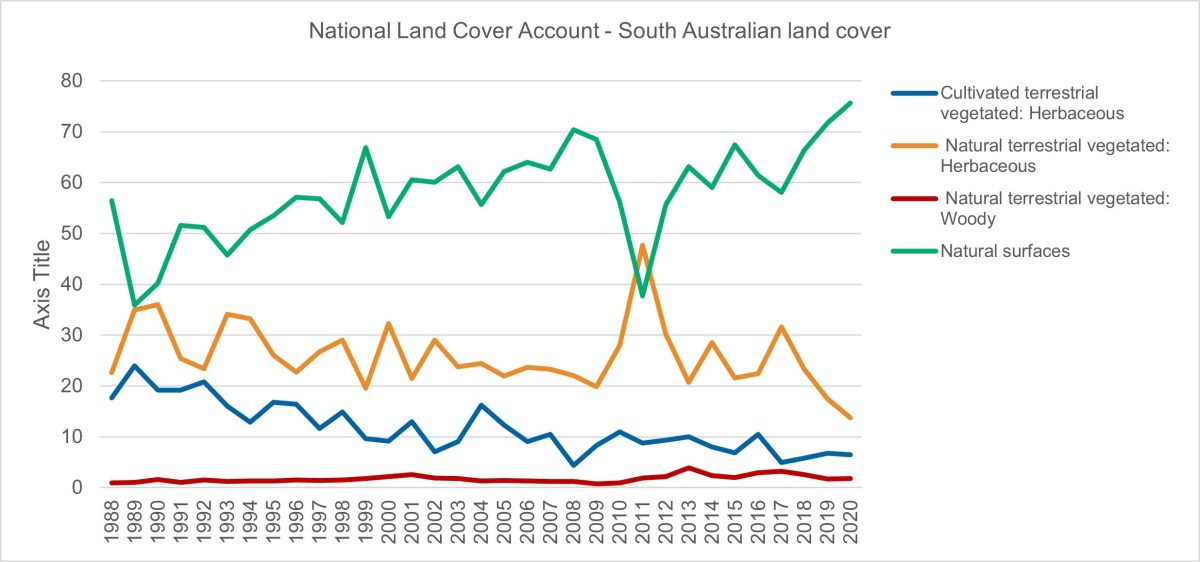
Natural terrestrial vegetated: herbaceous – areas dominated by grasslands and shrubs less than 2 m in height and woody canopy cover is less than 20%. Vegetation is not planted by humans but cover can be impacted by human activities (eg grazing).
Cultivated terrestrial vegetated: herbaceous – vegetation (eg crops, grasses and shrubs) that is planted or managed by humans (eg tillage, harvested, irrigated, grazed).
Natural terrestrial vegetated: woody – areas covered by woody vegetation including natural and plantation forests.
Natural surfaces – areas with less than 4% vegetative cover and is dominated by bare rock areas, sand and deserts.
In 2020, the statewide percentage cover of native vegetation was 87.8%. The extent of vegetation coverage varies across the nine landscape regions and appeared to be low in regions that support key agricultural areas and/or are developed.
Native vegetation is protected under the Native Vegetation Act 1991 and Native Vegetation Regulations 2017. Clearance of native vegetation may be required for a number of reasons and must comply with relevant guidelines or require approval under the Act by the Native Vegetation Council (NVC).
In 2022, 228 applications were received by the Native Vegetation Council with 776 hectares of clearance approved. It is noted that the introduction of the Native Vegetation Regulations 2017 changed the circumstances under which approvals were required from the Native Vegetation Council.
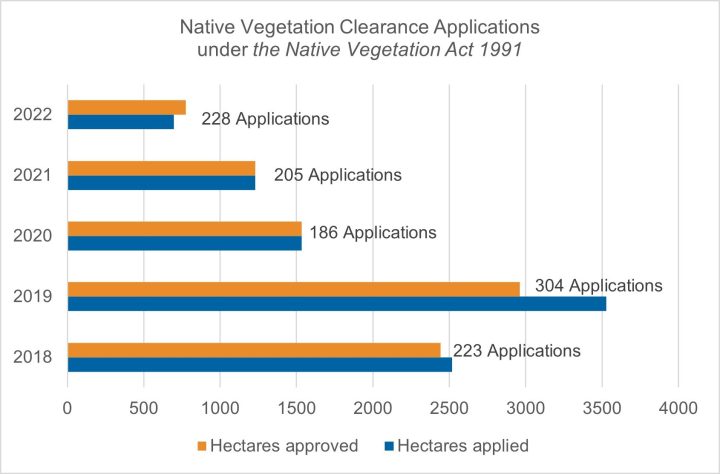
The Native Vegetation Overlay is included in the Planning and Design Code to facilitate the protection, retention and restoration of native vegetation to sustain biodiversity, threatened species and vegetation communities, fauna habitat, ecosystems services, carbon storage and amenity values.
Prescribed burns and cultural burns help manage the ecological health of habitats and protect them from bushfire risks and invasion of feral species by reducing fuel loads and promoting the growth of native vegetation. Cultural burns are also an integral part of Aboriginal culture in looking after and connecting with Country. There is a growing awareness of the importance and value that cultural burns have on Country.
Further reading
- Native Vegetation – Information on the protection and restoration of native vegetation from the Department for Environment and Water.
- South Australian Land Cover Layers: An Introduction and Summary Statistics 2018 – DEW technical report on summary statistics, large-scale trends and limitations for South Australian land cover between 1987 and 2015.
- A Guide for Applications to Clear Native Vegetation 2020 – A guide produced by DEW that identifies what needs to be addressed when applying to undertake clearance of native vegetation in South Australia and matters that are considered by the NVC when assessing applications.
- Guide to the Native Vegetation Regulations 2017 – A reference tool produced by DEW that outlines the circumstances where native vegetation clearance is permitted.
